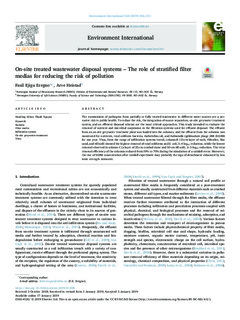| dc.description.abstract | The transmission of pathogens from partially or fully treated wastewater to different water sources are a pervasive risk to public health. To reduce the risk, the integration of source separation, on-site greywater treatment system, and an efficient disposal scheme are the most critical approaches. This study intended to evaluate the removal of nutrient and microbial suspension in the filtration systems used for effluent disposal. The effluent from an on-site greywater treatment plant was loaded into the columns, and the effluent from the columns was monitored for nutrients, total coliform bacteria, Escherichia coli, and Salmonella typhimurium phage 28B (St28B) for one year. Thus, from the range of infiltration systems tested, column-B (15 cm layer of each, Filtralite, fine sand, and till soil) showed the highest removal of total coliforms and E. coli, 3–4 log10 reduction, while the lowest removal observed in column-C (a layer of 25 cm crushed stone and 50 cm till soil), 2–3 log10 reduction. The virus removal efficiency of the columns reduced from 19% to 70% during the simulation of a rainfall event. Moreover, the rise of St28B concentration after rainfall experiment may probably the sign of detachment enhanced by low ionic strength rainwater. | nb_NO |

